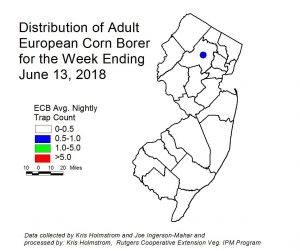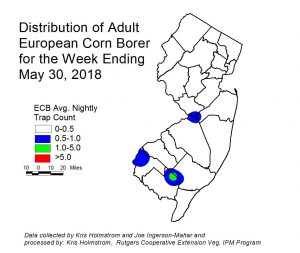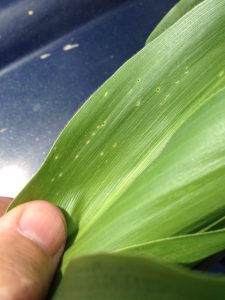Cucurbit downy mildew was confirmed on cucumber in Dorchester County, Maryland on 6/21/18. This is the first report of CDM in the mid-Atlantic region this growing season. All cucumber growers are encouraged to add downy mildew specific fungicides to their weekly maintenance spray programs. All growers should scout cucumber plantings as well as all other cucurbit crops for symptoms. To track the progress of cucurbit downy mildew in the US through the CDMpipe website through NCSU please click here.
Vegetable Crops Edition
Seasonal updates and alerts on insects, diseases, and weeds impacting vegetable crops. New Jersey Commercial Vegetable Production Recommendations updates between annual publication issues are included.
Subscriptions are available via EMAIL and RSS.
Quick Links:
 NJ Commercial Vegetable Production Recommendations
NJ Commercial Vegetable Production Recommendations
 Rutgers Weather Forecasting - Meteorological Information important to commercial agriculture.
Rutgers Weather Forecasting - Meteorological Information important to commercial agriculture.
Vegetable Disease Update – 6/14/18
- Dickeya dianthicola has been confirmed on ‘Norwis’ potato in New Jersey from seed originating from Prince Edward Island. This is the first report of Dickeya on potato in NJ this growing season. All potato growers should continue to scout their fields on a regular basis. Please contact your county agent if you find suspect plants.
- Pectobacterium spp. has been confirmed in southern NJ in ‘Dark Red Norland’ potato originating from P.E.I and in ‘Atlantic’ originating from Maine.
- Late blight was reported on tomato being sold as transplants in a retail operation last week near northeast Philadelphia. There has been no new information to date. Growers of tomato and potato should continue with their regular fungicide maintenance programs.
- Basil downy mildew was reported in potted basil being sold at a retail location in southern New Jersey.
- Bacterial leaf spot has been confirmed in pepper.
IPM Update 6/06/18
Sweet Corn
 European corn borer (ECB) moths have declined in black light traps, and numbers are now very low. The highest activity now in central Morris County (see ECB map). As is normal, when the adult generation winds down, feeding increases. IPM technicians have reported dramatic increases in feeding in whorl and pre-tassel stage plantings in the all counties. Numbers of infested plants have exceeded 30% in many areas. [Read more…]
European corn borer (ECB) moths have declined in black light traps, and numbers are now very low. The highest activity now in central Morris County (see ECB map). As is normal, when the adult generation winds down, feeding increases. IPM technicians have reported dramatic increases in feeding in whorl and pre-tassel stage plantings in the all counties. Numbers of infested plants have exceeded 30% in many areas. [Read more…]
IPM Update 6/06/18
Sweet Corn
 European corn borer (ECB) moths continue to be captured in black light traps, but numbers are low overall. Activity has shifted northward, with the highest activity now from Mercer County northward (see ECB map). Despite these low adult numbers, IPM technicians have reported dramatic increases in feeding in whorl stage plantings in the central and northern counties. Numbers of infested plants have reached 40% in the Somerville area, and 30% near Sparta in Sussex County. In many cases, nearby farms exhibit little or no feeding in similar stage sweet corn, so these elevated infestation rates can be highly localized. [Read more…]
European corn borer (ECB) moths continue to be captured in black light traps, but numbers are low overall. Activity has shifted northward, with the highest activity now from Mercer County northward (see ECB map). Despite these low adult numbers, IPM technicians have reported dramatic increases in feeding in whorl stage plantings in the central and northern counties. Numbers of infested plants have reached 40% in the Somerville area, and 30% near Sparta in Sussex County. In many cases, nearby farms exhibit little or no feeding in similar stage sweet corn, so these elevated infestation rates can be highly localized. [Read more…]
Rutgers Cooperative Extension of Gloucester County Has New Office Location
County Agricultural Agents, Michelle Infante-Casella and Hemant Gohil have a new office location in Gloucester County. The Rutgers Cooperative Extension (RCE) Office in Gloucester County relocated last week. The new location is now at the Shady Lane County Complex, 254 County House Road, Clarksboro, NJ 08020. The entrance is on the right side of the main 3-story brick building, under the numbers 254; follow the sidewalk with gray brick pavers.

Entrance to the RCE of Gloucester County Offices down the sidewalk on the right.
The office also has a new phone number and Agricultural Agents and other staff can be reached at 856-224-8040 (Agriculture and Natural Resources is extension 1). This new complex provided by Gloucester County offers more office space and multiple options for educational programs. To the left side of the complex is a 4-classroom building, formerly the Gloucester County Fire Academy, that is now operated by Rowan College of Gloucester County, that can be utilized for extension education and other county-related events. The main office building has 3 conference rooms for small group meetings. RCE will still have access to the main auditorium at the former facility in Clayton. For more information about Rutgers Cooperative Extension of Gloucester County see http://gloucester.njaes.rutgers.edu.
IPM Update 5/30/18
Sweet Corn
 Increasing numbers of European corn borer (ECB) moths have been captured this
Increasing numbers of European corn borer (ECB) moths have been captured this past week, but still relatively few moths overall. At present, the highest activity is on the Cumberland-Atlantic border, with minor concentrations in Salem and northern Burlington counties (see ECB map). As early sweet corn plantings progress through whorl and pre-tassel stages, feeding from this pest may be detectable. Look for the characteristic “shot-hole” type of feeding (photo at right) and consider treating when infested plants exceed 12% in a 50 plant sample.
past week, but still relatively few moths overall. At present, the highest activity is on the Cumberland-Atlantic border, with minor concentrations in Salem and northern Burlington counties (see ECB map). As early sweet corn plantings progress through whorl and pre-tassel stages, feeding from this pest may be detectable. Look for the characteristic “shot-hole” type of feeding (photo at right) and consider treating when infested plants exceed 12% in a 50 plant sample.
The highest nightly trap catches of ECB for the week ending 5/30/18 are as follows:
| East Vineland 2 | Centerton 1 | Eldora 1 |
| Allentown 1 | Cinnaminson 1 | Medford 1 |
| Belvidere 1 | Crosswicks 1 | South Branch 1 |
| Califon 1 | Denville 1 | Woodstown 1 |
